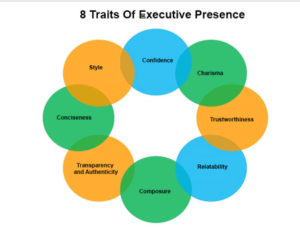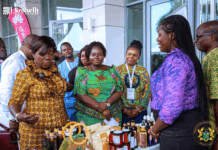In the fast-paced, high-stakes world of modern leadership, technical skills and domain expertise are table stakes.
Ambitious professionals fight tooth and nail to acquire the latest certifications, master the newest software platforms, and stay ahead of the curve on industry trends.
And yet, despite their impressive résumés, many struggle to truly command a room, inspire loyalty, and drive transformative results.
The reason? They’re missing a critical ingredient – the elusive yet immensely powerful quality known as “executive presence.”
I’ve had a front-row seat to this phenomenon over the course of my career as a Certified High Performance Coach and Image/Personal Brand Consultant.
Time and time again, I’ve witnessed talented, accomplished leaders fall short, not due to a lack of intelligence or work ethic, but because they haven’t fully developed this intangible “it” factor.
It’s a problem I’ve also observed firsthand when attending leadership conferences and events. Despite the emphasis on developing cutting-edge skills and strategies, the fundamental art of commanding attention and influencing others is often overlooked.

Attendees may walk away with a wealth of tactical knowledge, but remain ill-equipped to put it into practice in a truly impactful way.
This disconnect points to a deeper issue – the “lost language” of effective leadership. It’s a language that, when mastered, unlocks a leader’s full potential and separates the good from the great. And yet, it’s a language that far too many aspiring and established leaders have yet to learn.
The Power of Presence
So, what exactly is this elusive “executive presence,” and why is it so crucial for leadership success?
According to a recent Gartner survey of CIOs, it ranks as the second most important leadership trait, outpacing even technical skills and domain expertise. Dig a little deeper, and the reason becomes clear: Being perceived as leadership material is just as important as the actual skills and competence a leader possesses.
“Executive presence is a blending of temperament, competencies, and skills that, when combined, send all the right signals,” explains Suzanne Bates of Bates Communications. “Leaders know they must embody executive presence to get ahead, influence others, and drive results.”
Sylvia Ann Hewlett, author of “Executive Presence: The Missing Link Between Merit and Success,” goes even further, describing it as “an amalgam of qualities that telegraphs that you are in charge or deserve to be.” She emphasizes that this presence is essential for attaining top leadership roles, landing high-stakes deals, and developing a significant following.

At the heart of executive presence lies a potent mix of confidence, poise, and authenticity. Leaders who embody this quality exude a certain “wow factor” or magnetism that compels others to sit up and listen. They communicate with passion and energy, project an authoritative yet approachable demeanor, and engage their audience in a genuine, empathetic manner.
Communication expert Karen Friedman highlights several specific elements that contribute to this commanding presence:
- Confident and Commanding Presence: Standing tall, making strong eye contact, and using an authoritative tone of voice.
- Compelling Communication: Speaking up, using clear and concise language, and conveying ideas with enthusiasm.
- Positive Body Language: Offering a firm handshake, using open and purposeful movements, and projecting an air of confidence and approachability.
- Authentic Engagement: Listening attentively, empathizing with diverse perspectives, and inspiring others to follow.
The Consequences of the “Lost Language”
Despite the clear importance of executive presence, it is often overlooked or undervalued, especially in certain regions and cultures. Many leaders, even those with exceptional technical skills and domain expertise, struggle to effectively translate their knowledge and passion into meaningful influence and impact.
This is what I refer to as the “lost language” of leadership – the essential communication and interpersonal skills that differentiate truly outstanding leaders from their more technically proficient but less charismatic counterparts.
In my work with a wide range of professionals, I’ve witnessed this disconnect firsthand. Even at the highest levels of organizations, I’ve encountered leaders who simply don’t possess the innate “it factor” that is so critical for success.
The consequences of this lost language can be severe. Leaders without a strong executive presence often find themselves overshadowed, overlooked for promotions, and unable to rally their teams around a compelling vision. Their ideas, no matter how brilliant, struggle to gain traction, and their impact remains frustratingly limited.
The good news is that this “lost language” can be learned and developed through targeted training and coaching. While some elements of presence may come more naturally to certain individuals, the core skills and behaviors can be cultivated and refined over time.
Reclaiming the Language of Effective Leadership
So, how can aspiring and established leaders alike reclaim this lost language of effective leadership? Here are a few key steps:
- Recognize the Power of Presence
The first step is to fully internalize the significance of executive presence and its impact on career advancement and leadership success. Leaders must understand that technical skills and domain expertise, while essential, are not enough on their own. Projecting the right image, communicating with confidence, and engaging authentically with others are equally important.
- Assess Your Current Strengths and Gaps
Conducting an honest self-assessment is crucial. What are your existing strengths when it comes to executive presence? Where are the gaps or areas that need improvement? This evaluation should consider your communication style, body language, emotional intelligence, and overall “magnetism.”
- Seek Out Targeted Training and Coaching
Once you’ve identified the key areas for development, the next step is to actively seek out resources to help you build and refine your executive presence. This could include in-house training programs, workshops on personal branding and image, or one-on-one coaching with an experienced professional.
- Practice, Practice, Practice
Like any skill, developing executive presence requires consistent practice and refinement. Leaders should constantly seek out opportunities to apply what they’ve learned, whether it’s leading a critical meeting, delivering a high-stakes presentation, or engaging with key stakeholders. Feedback and self-reflection are vital in this process.
- Embrace an Iterative Approach
Building executive presence is not a one-time endeavor; it’s an ongoing journey of self-discovery and improvement. Leaders must be willing to adapt, experiment, and continue learning as their roles, contexts, and challenges evolve over time.
The Transformative Power of Presence in Action
One powerful example of the impact of executive presence can be seen in the career of Kamala Harris, the current Vice President of the United States.
Prior to her political ascent, Harris was known for her commanding presence and ability to command a room. As a prosecutor and California Attorney General, she developed a reputation for her sharp questioning, unwavering confidence, and effective communication style.
These qualities, combined with her impressive credentials and experience, helped propel Harris to the national stage, first as a U.S. Senator and then as the first female, first Black, and first South Asian American to hold the office of Vice President.
While Harris’s substantive knowledge and policy positions were undoubtedly critical to her success, her executive presence played a pivotal role in shaping perceptions and solidifying her status as a formidable leader. Her poise, passion, and authentic engagement with others have allowed her to connect with diverse audiences and exert significant influence.
In today’s rapidly evolving global landscape, the need for leaders who can effectively navigate complexity, inspire action, and drive positive change has never been greater. As industries and organizations grapple with disruptive technologies, shifting consumer preferences, and growing societal challenges, the ability to project confidence, communicate compellingly, and build meaningful connections has become increasingly essential.
Moreover, as the world becomes more interconnected and diverse, leaders must also possess the emotional intelligence and cultural awareness to engage productively with individuals from a wide range of backgrounds and perspectives. Executive presence, in this context, is not just about projecting authority, but about fostering genuine collaboration, empathy, and mutual understanding.
The time has come for leaders, at all levels, to reclaim the “lost language” of effective leadership – to embrace the power of presence and use it as a catalyst for driving innovation, influencing outcomes, and elevating their organizations and communities.
By investing in the development of this critical skill set, leaders can unlock their full potential, position themselves for greater success, and ultimately, make a more meaningful and lasting impact on the world around them.
Are you ready for TRANSFORMATION?
Dzigbordi Kwaku-Dosoo is a Ghanaian multi-disciplinary Business Leader, Entrepreneur,
Consultant, Certified High-Performance Coach (CHPC™) and global Speaker.
She is the Founder and CEO of The DCG Consulting Group.
She is the trusted coach to top executives, managers, teams, and entrepreneurs helping
them reach their highest level of performance through the integration of technical skills
with human (soft)skills for personal development and professional growth, a recipe for
success she has perfected over the years.
Her coaching, seminars and training has helped many organizations and individuals to
transform their image and impact, elevate their engagement and establish networks
leading to improved and inspired teams, growth and productivity.










